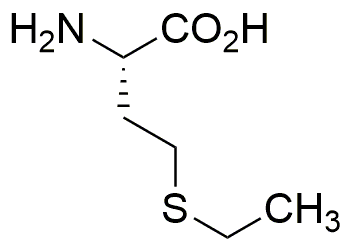L-Ethionine is widely utilized in research focused on various applications:
- Amino Acid Supplementation: Commonly used in dietary supplements, L-Ethionine can enhance protein synthesis and support muscle recovery, making it popular among athletes and fitness enthusiasts.
- Pharmaceutical Development: This compound plays a role in drug formulation, particularly in studies related to liver health and detoxification, offering potential therapeutic benefits for conditions like fatty liver disease.
- Biochemical Research: In laboratories, L-Ethionine is used as a model compound to study sulfur-containing amino acids, aiding researchers in understanding metabolic pathways and enzyme functions.
- Animal Nutrition: It is incorporated into animal feed to promote growth and improve overall health in livestock, which can lead to better productivity in the agricultural sector.
- Cosmetic Formulations: L-Ethionine is explored in cosmetic products for its potential antioxidant properties, contributing to skin health and anti-aging effects.
General Information
Properties
Safety and Regulations
Applications
L-Ethionine is widely utilized in research focused on various applications:
- Amino Acid Supplementation: Commonly used in dietary supplements, L-Ethionine can enhance protein synthesis and support muscle recovery, making it popular among athletes and fitness enthusiasts.
- Pharmaceutical Development: This compound plays a role in drug formulation, particularly in studies related to liver health and detoxification, offering potential therapeutic benefits for conditions like fatty liver disease.
- Biochemical Research: In laboratories, L-Ethionine is used as a model compound to study sulfur-containing amino acids, aiding researchers in understanding metabolic pathways and enzyme functions.
- Animal Nutrition: It is incorporated into animal feed to promote growth and improve overall health in livestock, which can lead to better productivity in the agricultural sector.
- Cosmetic Formulations: L-Ethionine is explored in cosmetic products for its potential antioxidant properties, contributing to skin health and anti-aging effects.
Documents
Safety Data Sheets (SDS)
The SDS provides comprehensive safety information on handling, storage, and disposal of the product.
Product Specification (PS)
The PS provides a comprehensive breakdown of the product’s properties, including chemical composition, physical state, purity, and storage requirements. It also details acceptable quality ranges and the product's intended applications.
Certificates of Analysis (COA)
Search for Certificates of Analysis (COA) by entering the products Lot Number. Lot and Batch Numbers can be found on a product’s label following the words ‘Lot’ or ‘Batch’.
*Catalog Number
*Lot Number
Certificates Of Origin (COO)
This COO confirms the country where the product was manufactured, and also details the materials and components used in it and whether it is derived from natural, synthetic, or other specific sources. This certificate may be required for customs, trade, and regulatory compliance.
*Catalog Number
*Lot Number
Safety Data Sheets (SDS)
The SDS provides comprehensive safety information on handling, storage, and disposal of the product.
DownloadProduct Specification (PS)
The PS provides a comprehensive breakdown of the product’s properties, including chemical composition, physical state, purity, and storage requirements. It also details acceptable quality ranges and the product's intended applications.
DownloadCertificates of Analysis (COA)
Search for Certificates of Analysis (COA) by entering the products Lot Number. Lot and Batch Numbers can be found on a product’s label following the words ‘Lot’ or ‘Batch’.
*Catalog Number
*Lot Number
Certificates Of Origin (COO)
This COO confirms the country where the product was manufactured, and also details the materials and components used in it and whether it is derived from natural, synthetic, or other specific sources. This certificate may be required for customs, trade, and regulatory compliance.


